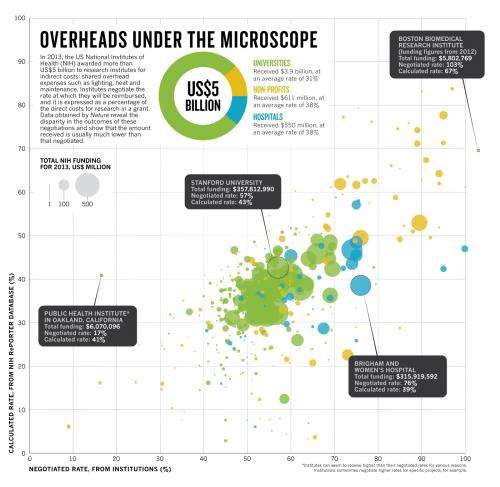November 20, 2014 report
Journal shines a light on the high cost of indirect spending as part of research grants

(Phys.org) —Heidi Ledford, a staff writer for the journal Nature, has posted a News Feature piece in the current issue of the journal highlighting how much of tax dollars are now going to support indirect spending when the government hands out research grants. In her piece, Ledford notes that a maze of regulations and indirect costs are making it more difficult for universities and other institutions to carry out their research and suggests that more transparency in the process might make things easier to "bear."
Ledford (backed by a team of researchers at Nature) notes that scanning data obtained via the Freedom of Information Act, reveals that there are huge differences in reimbursement rates between different universities—an indication, perhaps, of a lack of standardization in the process. She also notes that the records show that in addition to doling out reimbursements for costs directly associated with research, the government also gives money back to institutions for such things as library subscriptions, Internet access, electricity, and a whole host of over overhead items. Indeed, she and her team found instances of the government paying for depreciation on buildings and even interest on debt.
The problem lies perhaps with legislation in the 1960's that allowed those that receive grants to negotiate with the government entities that provide the money. While this might seem to benefit certain entities (those with the best negotiators), the data shows that virtually all of those entities that receive grants don't get reimbursed at the levels specified in the grants due to caps and other regulations—few they note get more than 70 percent. The result is that research institutions, which are mainly universities, are finding it more and more difficult to maintain their research initiatives, as they are often money drains.
Another interesting bit of information gleaned from the data—just nine universities receive approximately a sixth (a billion dollars) of all funds given out for research—not coincidently, they also tend to negotiate higher than average amounts of reimbursement—Johns Hopkins University, tops the list, receiving almost half the billion all by itself.
Ideally, Ledford notes, every penny given out by the government would go towards the direct costs involved in providing research—but realistically, that ideal won't work. Researchers do their research in buildings that involve overhead and other indirect costs, and expecting institutions to cover those themselves isn't sustainable. To counter arguments against paying for such costs, she suggests making the entire system more transparent so that anyone looking can very easily see where the money goes and why it's needed.
More information: Indirect costs: Keeping the lights on, www.nature.com/news/indirect-c … he-lights-on-1.16376
Journal information: Nature
© 2014 Phys.org



















